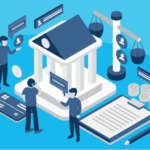Why MSME Lending Needs to Break Free from Personal Loan Thinking – Micro, Small, and Medium-Sized Enterprises (MSMEs) form the foundation of employment, innovation, and growth in the changing economic scenario. Yet, beyond their significance, the lending scenario for MSMEs tends to reflect the tactics and mindset of personal loans, which is not only inefficient but also potentially risky. We urgently need to abandon the outdated personal loan model to enable MSMEs and unlock their full potential.

The Problem: No Two Individuals Are Alike
The one-size-fits-all strategy is the primary problem with treating MSME lending as personal lending. An individual’s income, credit history, and payment record are primarily considered when evaluating personal loans.
Even though this is effective for financing customers, it is a complete failure when it comes to business lending, where the factors are much more complex. MSMEs are different. They handle moving inventories, deal with seasonal variation, have clear cash flow cycles, and operate in different fields. Applying the same standards to small businesses as to salaried professionals oversimplifies risk, limits access to credit, and results in bad lending choices.
Identifying the Complexity of MSME
Particularly in emerging economies, MSMEs often lack official credit histories, different to people. They might have inconsistent financial documentation and disjointed business records. However, these businesses have strong informal measures of reliability, like vendor relationships, repeat business, and community standing, which are disregarded in conventional underwriting models, and they are operationally sound.
Frameworks for personal loans fully overlook these subtleties. High rejection rates or mispriced loans result from their choices for static data over dynamic business signs.
Income-Based Lending Versus Cash Flow
Most personal loans are based on income. To evaluate repayment capacity, they depend on a continuous monthly income. On the other hand, MSMEs follow cash flow cycles that can transform on a monthly or quarterly basis. In the off-season, a business may look risky, but in the year-round, it may work well.
A shift to cash flow-based lending, which makes use of digital payment trails, inventory turnover, or transaction data, would offer a more realistic view of a firm’s financial condition. This calls for new tools made particularly for MSMEs as well as a change in perspective.
Technology-Powered Credit Models: An Improved Choice
More intelligent, context-driven lending models are being made possible by coming fintech solutions. Lenders can more accurately decide reliability by using AI, machine learning, and alternative data (like bank statements, GST filings, and e-commerce records). Despite of presuming a linear salary-to-debt ratio, these models take into consideration the rhythms and realities of working a business.
Big amounts of MSME data can be processed quickly by digital lending platforms, enabling more inclusive financing, enhanced risk management, and faster disbursement. However, lenders must give up personal loan paradigms to completely benefit from this.
Collateral Difficulties
The dependence on collateral is another factor contributing to MSMEs’ worthless. Some type of security, like savings, gold, or property, is needed by personal loan frameworks. Apart from having workable business plans, various MSMEs specifically micro and startup businesses do not have the needed collateral.
Instead of depending on tangible assets, contemporary MSME lending should move toward unsecured or low-collateral products supported by strong risk analytics. Peer lending, government-backed programs, and credit guarantees can all reduce risk for lenders while enhancing borrower confidence.
Policy Change and Regulatory Assistance
The requirement for specialized MSME support has been brought to light by government programs like the Emergency Credit Line Guarantee Scheme (ECLGS) in India and the Paycheck Protection Program (PPP) in the US during COVID-19. Long-term change, however, required legislative changes that start distinct credit evaluation standards for MSMEs, separate from those governing corporate or personal lending.
Moreover, public-private partnerships that ease data sharing for MSME evaluation, open banking adoption, and creativities in credit scoring should all be supported by regulatory frameworks.
Relationship Banking As an Alternative to Transactional Lending
The mindset of lenders must also change from transactional to relational. Personal loans are often one-time purchases. MSMEs, on the other hand, need a long-term financial partner who is knowledgeable of their industry, growth goals, and hardships.
To offer context-aware loans, banks and fintechs required to make investments in learning about fields like production, retail, or agribusiness. Better credit structuring, better repayments, and customer retention are all made possible by relationship banking.
The Path Ahead
Breaking free from personal loan thinking needs a structural and philosophical transformation in addition to a technological advancement. It needs –
A greater use of alternative and real-time data, flexible repayment plans based on cash flow, reduced collateral requirements, proactive lender-borrower engagement, and custom underwriting models that take into account MSME business cycles.
These adjustments can significantly improve MSME credit availability, reduce default rates, and increase economic rise if they are put into practice.
Conclusion
Apart from being our economies’ main drivers of growth, MSMEs are being hampered by an antiquated lending philosophy. The breadth, depth, and possibility of MSMEs’ business models are not completely captured when they are treated like individuals. To truly show the entrepreneurial spirit they represent, a new era of MSME financing must leave the personal loan mentality and adopt creative, adaptable, and business-oriented strategies.
FAQs
Why is it harmful for MSME lending to consider personal loans?
Static credit scores, individual-level risk metrics, and fixed income are the basis of personal loan thinking. However, on the other hand, MSMEs face seasonal fluctuations, business-centric risks, and dynamic cash flows. Growth is eventually disrupted by the use of personal loan models, which result in imprecise credit evaluations, enhanced rejection rates, and mispriced interest rates.
What distinguishes personal lending from MSME lending?
MSME lending involves assessing a company’s full operational health, including revenue cycles, supplier networks, and customer behavior. Apart from having no official financial records, various MSMEs are reliable according to other criteria. Compared to personal finance, this complexity requires more advanced evaluation techniques.
How can technology improve access to MSME credit?
To decide reliability, fintech solutions can inspect alternative data, like e-commerce performance, utility payments, or digital transactions. Lenders can make more data-driven, faster, and fair decisions with the help of AI-driven models. Moreover, technology makes it possible for flexible repayment plans, ongoing monitoring, and faster disbursements.
What policy modifications can ease improved lending to MSMEs?
Governments and regulators can promote open banking, support alternative credit scoring models, promote unsecured loans via credit guarantees, and start distinct credit assessment standards for MSMEs. Relationship-based lending will also be enhanced by educating lenders about MSME industries.








